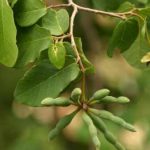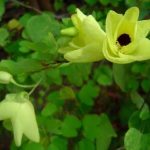TREE LIFE
JULY 1980
MASHONALAND CALENDAR
Saturday July 5th : Instead of the usual Botanic Garden walk on this day we are going to visit the Lake McIlwaine Arboretum on the banks of the lake, just above the Dam Wall. In the 1950’s and 1960’s members of this Society worked very hard to create this Arboretum and this will be an opportunity for newer members and visitors to see the Arboretum. Meet at Marimba Shopping Centre at 0900 hours to share lifts. Bring picnic lunch if you plan to stay until the afternoon.
Sunday 20th July : Trip to Darwendale Dam. We have booked an Express Motorways bus for this trip which will depart from the Car park west of the Monomatapa at 0830 hours. Alternative meeting place, Marimba Shopping Centre at 0845 hours. Fare will be $4.00 with reduction if all seats are filled. Booking slip attached.
We will go into Darwendale Dam via Norton and the Lydiate Road. This will be our first visit to the Dam Wall since our trip just prior to construction starting, so it will be interesting to see the change. As on that occasion, we hope that Mr. Trevor Gordon will lead us through this interesting Great Dyke area.
Saturday 2nd August : Botanic Garden Walk
BOTANIC GARDEN WALK : Saturday 7th June
Left to our own devices, we once again tried to sort out Acacia identification.
Two subspecies of A. nilotica are growing in the gardens, and in this habitat at least, are quite distinct. The common name is “scented pod acacia”, but only the pod of subsp. kraussiana bore the aromatic smell associated with this species, and differed further from the subsp. adansonia, by bearing smaller leaflets and thorns, and narrower pods with more clearly defined constrictions between the seeds. Acacia kirkii, flood plain acacia, is very isolated in its Zimbabwean distribution, but looked healthy in its Salisbury climate. The bark is rather luminous green and papery, reminiscent of the commiphoras.
MAKABUSI WOODLANDS ASSOCIATION – In the June Newsletter I mentioned the Association’s open day of 27th July, and the Douglas Aylen Memorial Fund to which members were asked to contribute. There has to date been no further news of the open day in the press, but members are asked to look out for this and attend, if possible.
Latest news from the MWA is that all is going well as regards the lease, and those of you who still scan the paper will have seen that the Mayor of Salisbury, Councillor Jack Whiting, became the first “Friend of the Makabusi Woodlands”.
There is, however, still much to be done in the way of raising funds for building and maintenance, and I am sure that our pledged $500 will be gratefully received. Once again it is hoped that members will contribute to the D. Aylen Memorial Fund.
A representative of the MWA will be attending the Lions International Conference in Chicago on 22nd July, and we wish them luck in putting across their objectives at this meeting.
Recently too, a team of experts visited the Woodlands to advise on management. Their report indicates that, whilst the Makabusi is a valuable educational and recreational area, it is far from pristine. Over the years topsoil has been stripped from some areas, various trees and shrubs cut out, and the annual hot burn damaged much regeneration. In view of this they have recommended that some indigenous trees be reintroduced near the proposed interpretative centre. If any members have indigenous trees they do not want please contact either myself, Cheryl Haxen, Department of Zoology or Norman Dennett, Department of Linguistics, University, ext. 190.
Especially recommended by the team were Acacias, Combretums, Grewias, Peltophorum africanum, Dichrostachys cinerea and a range of bird attracting species like Ficus, any species, Syzygium, Cassine, sp etc. So all of you who collect seed and have them still sitting in packets, better start preparing some germination boxes.
With such an appeal in mind, it may be worth while to introduce some organisation into the Society’s tree growing efforts. If the proposed National Tree Planting planned for November gets away, the N.R.B and other organisations involved will need all the help they can get, and the following may be a starting point:
Indigenous Tree Growers Association – Meg Coates Palgrave has reminded me that we have talked about this one for some time. I think it is safe to say that most keen growers of indigenous trees are members of the Tree Society, but not all members of the Society do, in fact, grow indigenous trees. Overstating a simple point maybe, but what I am getting at is there is there a need for a separate organisation or can the needs of ‘growers’ be catered for within the operation of the Society.
We have campaigned over the years to get commercial nurserymen to go in for indigenous trees and whilst they report to us that there is still much consumer resistance, is it through lack of knowledge and understanding by the average gardener, certainly more indigenous plants are available at nurseries than say a decade or so ago.
Do we need more, the aims and objectives of our Society cover propagation of indigenous trees, but perhaps there is in fact need for specialised interchange of ideas between members who grow trees, which may not be of general interest to all members. Perhaps the first stage is the compilation of a register of members, and maybe others, who do propagate indigenous trees and would like to cooperate with others. There may in fact be a substantial need for this in respect of those members outside Salisbury, remember members are keeping in touch continually, and to swop seed and seedlings, so if any member is interested in this, write in and we will compile a register as a first step, and then take it on from there.
HALLAM DAM VISIT 15TH JUNE
Meg Coates Palgrave writes “What a lovely spot we visited on Sunday 15th June, and what perfect time of year we chose for that visit. In landscaping the area nature made full use of the aloes and boulders. We thoroughly enjoyed having members of the Aloe, Cactus and Succulent Society with us and hope that they were not disappointed that the aloe family appeared to be represented by only Aloe chabaudii and A. excelsa. But perhaps they saw more than we tree people who had so much else to look at.
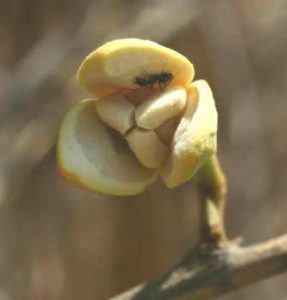
Annona senegalensis. Bart Wursten. Source: Flora of Zimbabwe
Between Anton Elert and myself we recorded over 90 species although not all of them could really be classified as trees. One of Anton’s finds, Annona stenophylla, described as a shrub or “rhizomatous shrublet” sounds a very low form of life. Surely no plant deserves such an epithet. It appears to be very similar to its large counterpart the custard apple, Annona senegalensis.
The delightful Mundulea sericea was prevalent, tending to be a silvery pink. I have always thought that the specific name “sericea” referred to a silver colour. In fact, it comes from the Latin “sericus” meaning “silken”. Osyris lanceolata (in flower) is a species not on our field card. This has a grey green leaf with a sharp point on the apex. Another one not on the card was “my” tree, which proved to be Cordia sinensis. It was in fruit, this being similar in appearance to an elongated acorn, with a long tip and persistent toothed calyx. The latter tends to remain on the plant, after the fruit has fallen; a feature shared by other Cordias.
Talking of fruit, the Mukwa, Pterocarpus angolensis was spectacular. What a design this could make. Another potential fabric design was the lovely fruit of Monotes glaber of which we saw a number. Ozoroa reticulata was also in fruit with its ripe ‘raisins’, Vitex payos with its ‘chocolate berries’ and the long tail cassia, apparently inappropriately named Cassia abbreviata, with its long pods.
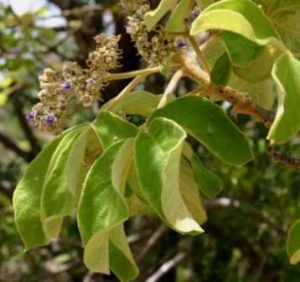
Vitex payos. Photo: Bart Wursten. Source: Flora of Zimbabwe
In the afternoon an anthill provided one of the highlights, Pappea capensis in fruit. Most fruit had either fallen or was past its prime, the orange jelly having faded to a brownish colour, known also as Lobengula’s Indaba Tree, P. capensis with its pale stems and toothed leaves, if often found on anthills.
Grewia decemovulata, also in fruit was growing a little taller than we normally expect, while Faurea saligna all tended to be small and sturdy.
All in all another day of wonderful tree memories.
MATABELELAND BRANCH
Sunday July 6th : Meet in the City Hall Car Park at 0830 hours to visit an area of Kalahari sand vegetation near the Airport. Take morning tea.
Sunday August 3rd : Meet at Hillside Dam, on the upper Dam Wall at 0830 hours. We will be using the key of “Trees of Southern Africa”. Take morning tea.
CORRECTIONS TO MAY NEWSLETTER
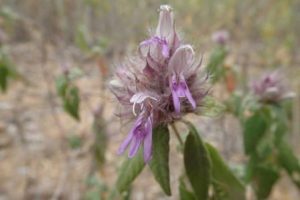
Lepidagathis scariosa . Photo: G. Masterson. Source: Flora of Zimbabwe
“Gremlins” are responsible for the error in the notes on Umniati. Mrs. Masterson’s collection of Lepidagathis scariosa was the second, not in Central Africa, but in the “Central area” of this country’s floral divisions. This small plant with pretty blue flowers was found near the base of the low dolorite dyke and is a member of the ACNTHACEAE, an interesting family in which are found many garden plants but apparently few trees or shrubs. One seen regularly by our Bulawayo Branch in the Matopos is Barleria albostellata with its striking white foliage and flowers. To find it near Salisbury I believe we would have to go beyond Shamva or Mrewa.
Going back to the floral divisions of this country. Page xii of the Rhodesian Botanical Dictionary by Wild revised and updated by Biegel and Mavi gives a description of what is involved. I am always very pleased when our Society in a small way is able to add to the general fund of knowledge by making collections of importance like this.
REVISED EDITION OF ‘TREES OF SOUTHERN AFRICA’ by Keith Coates Palgrave
The following letter was received : “The first edition of this book is almost sold out, and a slightly revised second edition is being planned for 1981. I would be most grateful to know of any inaccuracies, inconsistencies and omissions, by the end of 1980 so that these can be corrected in the next edition” Will members please send their comments to : Eugene Moll (Editor), C/o Department of Botany, University of Cape Town, Rondebosch 7700. Cape.
NEWS FROM FRIENDS OUTSIDE ZIMBABWE – Desiree Watson writes in with news of Dix Airey from Natal. He, of course, maintains a keen interest in trees, and would like the Tree Society to know that plans are afoot to start a ‘Tree Branch” of the Durban Wildlife Society.
Desiree is at present doing voluntary work in the U.K. but is expected to return early next year. She thanks all friends in the Society for the enjoyable and memorable outings.
Another former member sending news is Natalie Sillery of Fish Hoek. She writes “Please give my good wishes to the Society. The nearest I have found here so far is to be a member of various ‘hacking’ groups in Simonstown, Fish Hoek and Kalk Bay – we attack the Hakea and other Australian species introduced here years ago, which are taking over the hillsides and killing the natural fynbos”.
OUTING OF THE ALOE, CACTUS AND SUCCULENT SOCIETY : This Society hopes that our members may join them on their proposed Christon Bank outing, probably the first weekend of August. If any members are interested contact Mrs. D.Popiel – Tel. 36786. Other forthcoming outings and evening meetings of the A.C.S.Society may also be of interest. Details from Mrs. Popiel.
SPECIAL FIELD TRIPS – with what we trust will be a continuing improvement in the field of Law and Order the Tree Society wants to plan trips to places of particular interest which have been inaccessible in recent years. The top of Chimanimani with its unique environment is merely one of such places. These will be specialised outings, and again, to use Chimanimani as an example, will be for a select group of not much more than half a dozen, prepared to “rough it” on top of the mountain for several days. Members (and others) interested please contact George Hall for details.
TREES AND NON TREES
Reference elsewhere in this newsletter to the ground layer plant L. scariosa reminds me that people sometimes query why a Tree Society bothers about ‘non-trees’. My answer is that whilst trees are our main concern, we are interested in the whole environment and all the complex inter-relationships between plant and animal life. Further, sometimes the dividing line is not easy to determine. In studying the genera : Lannea, Syzygium, Combretum, Parinari one can hardly ignore the dwarf species. In the case of the last mentioned, P. capensis an outright ground layer plant, is smaller in height than L. scariosa. then there are the plants which be either/or. One which springs readily to mind is Sarcostemma viminale which we commonly see as a prostrate succulent creeper, scrambling over bare granite but which can under certain conditions form a trunk 8 inches in diameter going up to over 7 feet high before forming its succulent canopy. S. viminale is an A. sclepediaceae and with its thick white latex, nothing to my mind looks less edible, if not outright poisonous. It was therefore with some surprise that I recently learnt that this plant in the Karroo is considered good sheep browse and is also eaten by humans both as a green salad and cooked as a relish.
TEMNOCALYX OBOVATUS, A BUSH TEA (Makoni Tea Bush)
This plant was first pointed out to me by a tribal person, a number of years ago as a ‘tea bush’. Later, I collected some leaves, took them home and dried them in the oven, when they were crisp I brewed a cup of tea which was quite pleasant to the taste, however, a few hours later I developed a headache, a mild one, but enough for me to connect it with the ‘cup of tea’. A few days later I met this same person in the street and told him of my headache. He pointed out that I had been wrong in artificially drying the leaves, I should have waited until they dried naturally.
The next time I experimented I made sure that I did just this and the result was no side effects. When the leaves dry out naturally, reduce them to fragments, pour on boiling water, stir until the leaves have sunk and drink immediately. I find that if the tea begins to cool a certain bitter taste develops, but some might in fact develop a liking for this. Like china tea, no milk or sugar. I would be interested to hear the comments of professional tea tasters on the world markets. I hope it never becomes too popular because T. obovatus is not very common.
-George Hall
GEORGE HALL CHAIRMAN


